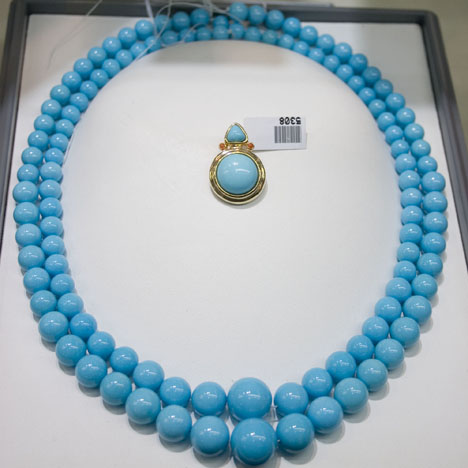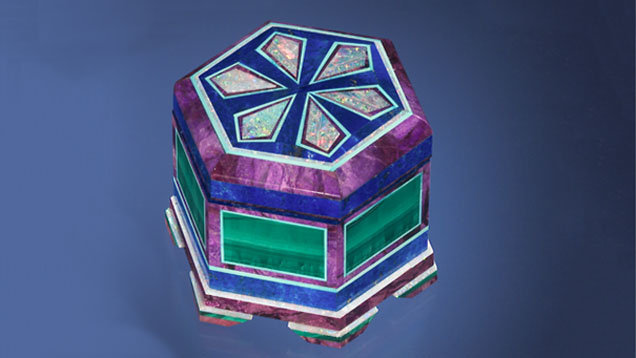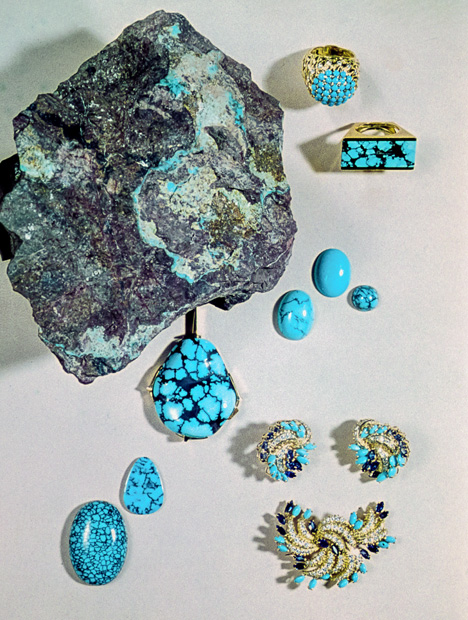Turquoise Quality Factors | Different Types & Colors of Turquoise | GIA (original) (raw)
The green turquoise cabochon, from an American mine, might become part of a designer’s unique jewelry piece. The even blue color of the cabochon on the right would be called “Persian blue” in the trade. Photo: Robert Weldon/GIA, Dr. Eduard J. Gübelin collection.
Fine-quality turquoise is sought after around the world by designers of unusual jewelry pieces.
Typically, turquoise is judged on three basic quality factors—color, texture, and the presence or absence of matrix.
Turquoise Color
Blue Turquoise
The most-prized turquoise color is an even, intense, medium blue, sometimes referred to as robin’s egg blue or sky blue in the trade. The traditional source for this color is the Nishapur district of Iran, so you’ll also hear it described as “Persian blue,” whether or not it was actually mined in Iran.
Green Turquoise
Generally speaking, turquoise with a green to greenish blue color is less desirable than turquoise with a pure blue hue, but it depends on personal preference. There are some contemporary designers who actively seek avocado and lime green turquoise.

The turquoise in the brooch and graduated bead strands is from Arizona’s Sleeping Beauty Mine. Its smooth, even color represents the appearance prized by most collectors. - Photo: Valerie Power/GIA. Courtesy: GLEAM
- Courtesy GLEAM
Turquoise Pattern
Turquoise can be semitranslucent to opaque, with a color that usually ranges from light to medium blue or greenish blue. It’s often mottled and sometimes has dark splotches. It might also have veins of matrix running through it (matrix is a remnant of its surrounding rock). The material known as spiderweb turquoise contains fine seams of matrix that form attractive web-like patterns.
These free-form turquoise cabochons show a typical matrix pattern. Photo: GIA
The most valuable turquoise is an even medium blue, with no matrix and the ability to take a good polish.
Turquoise Cut
Turquoise is most often cut as a cabochon. The smoothly rounded dome shape sets off turquoise’s color, texture, and any matrix beautifully. In addition, manufacturers and artisans fashion turquoise into round or oblong beads for strand necklaces, and into small, flat pieces that are popular in jewelry inlays. Some top-color blue turquoise is engraved with Persian or Arabic inscriptions, inlaid with gold. Lower-quality rough material might be tumbled into “nuggets."
This stylish and unusual “Pegged Nugget” bracelet contains about 100 flat turquoise nuggets that are attached with flat silver pegs. -– Photo: Maha Tannous/GIA. Gift of Robert Lee Morris

This intarsia box created by Nicolai Medvedev includes flat pieces of turquoise as part of its inlaid design. -– Photo © GIA & Tino Hammid, gift of Carol and Fred Seeman
Turquoise Carat Weight
Turquoise is weighed in carats, and five carats equal one gram. Turquoise is available in a wide range of sizes. All sizes, even very small stones, are used in Native American jewelry, and large pieces of turquoise rough are popular for carvings. For any size, the quality and evenness of the color is the overriding value factor.

A single large piece of rough can yield severalmuch smaller pieces of fine, evenly colored turquoise. A gem cutter has to work around the host rock to avoid ending up with a much less valuable gem. Photo: GIA, Dr. Eduard J. Gübelin collection.